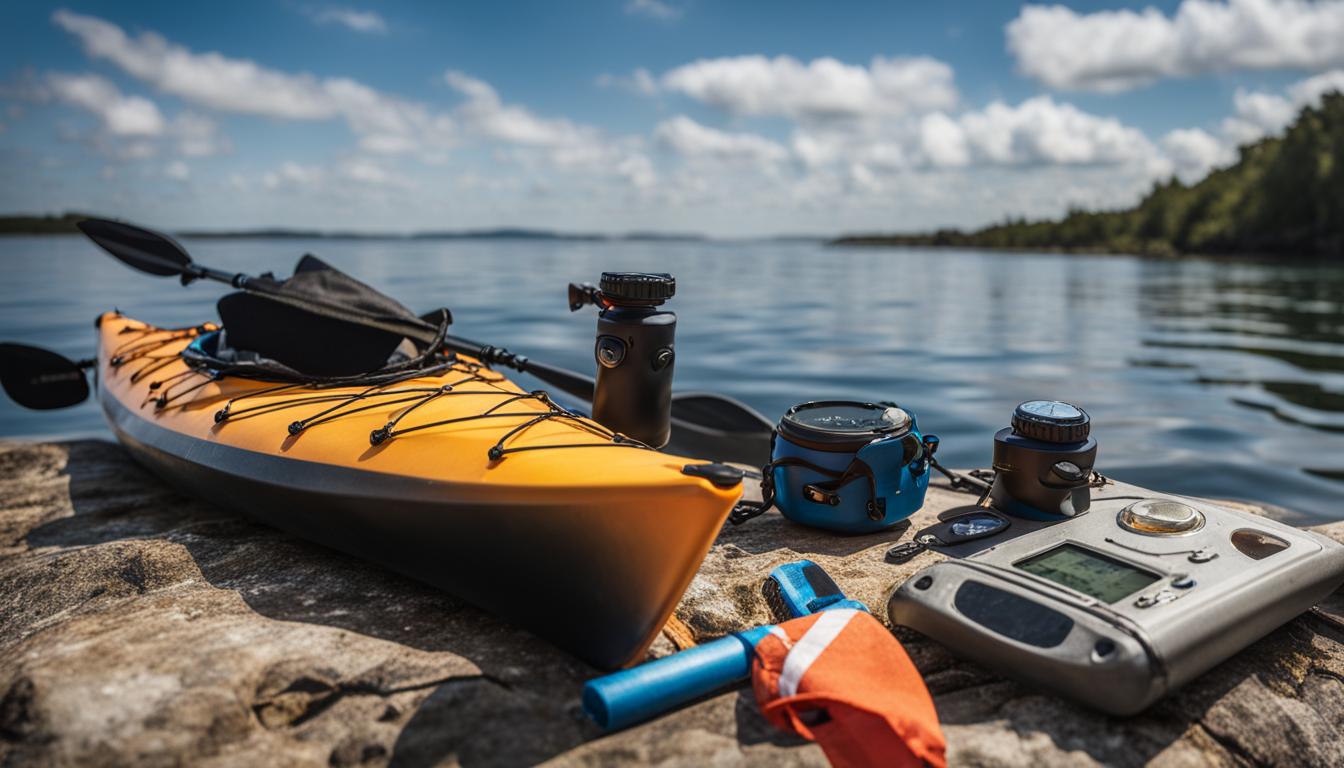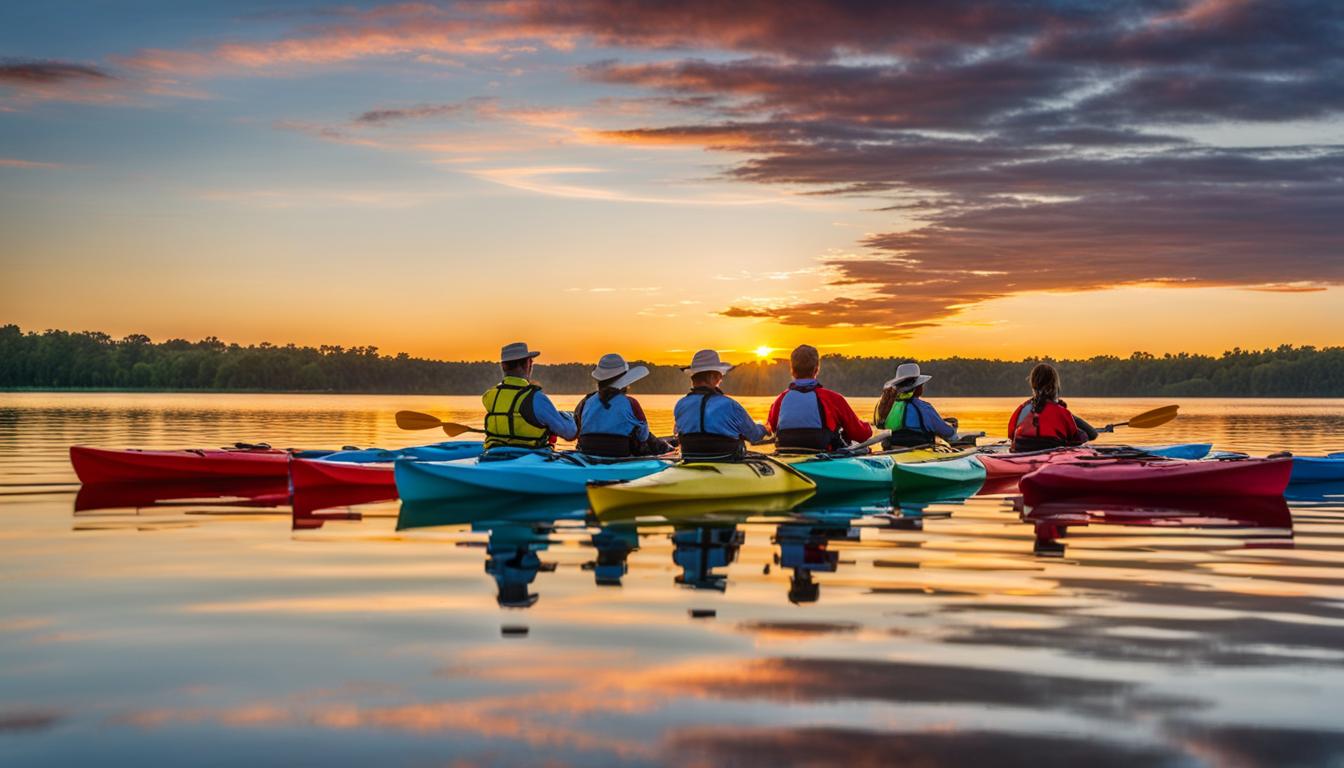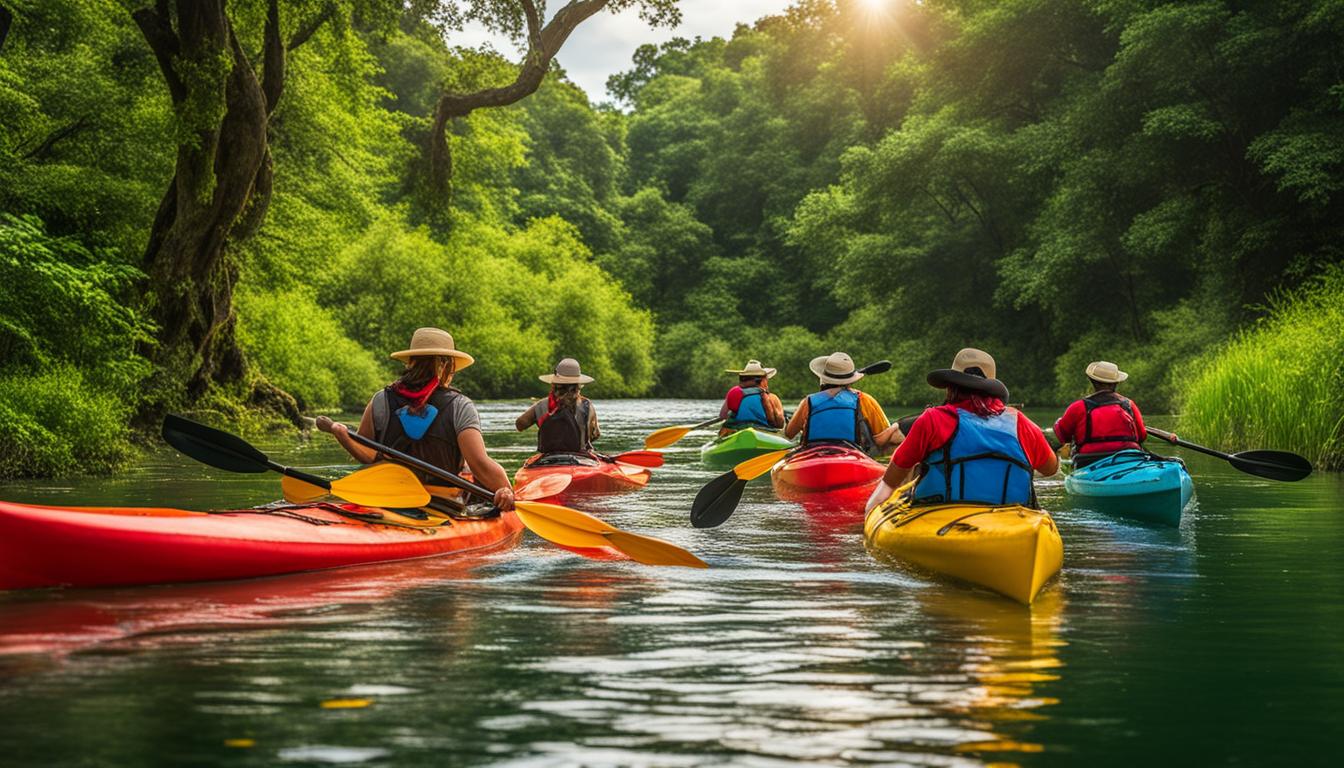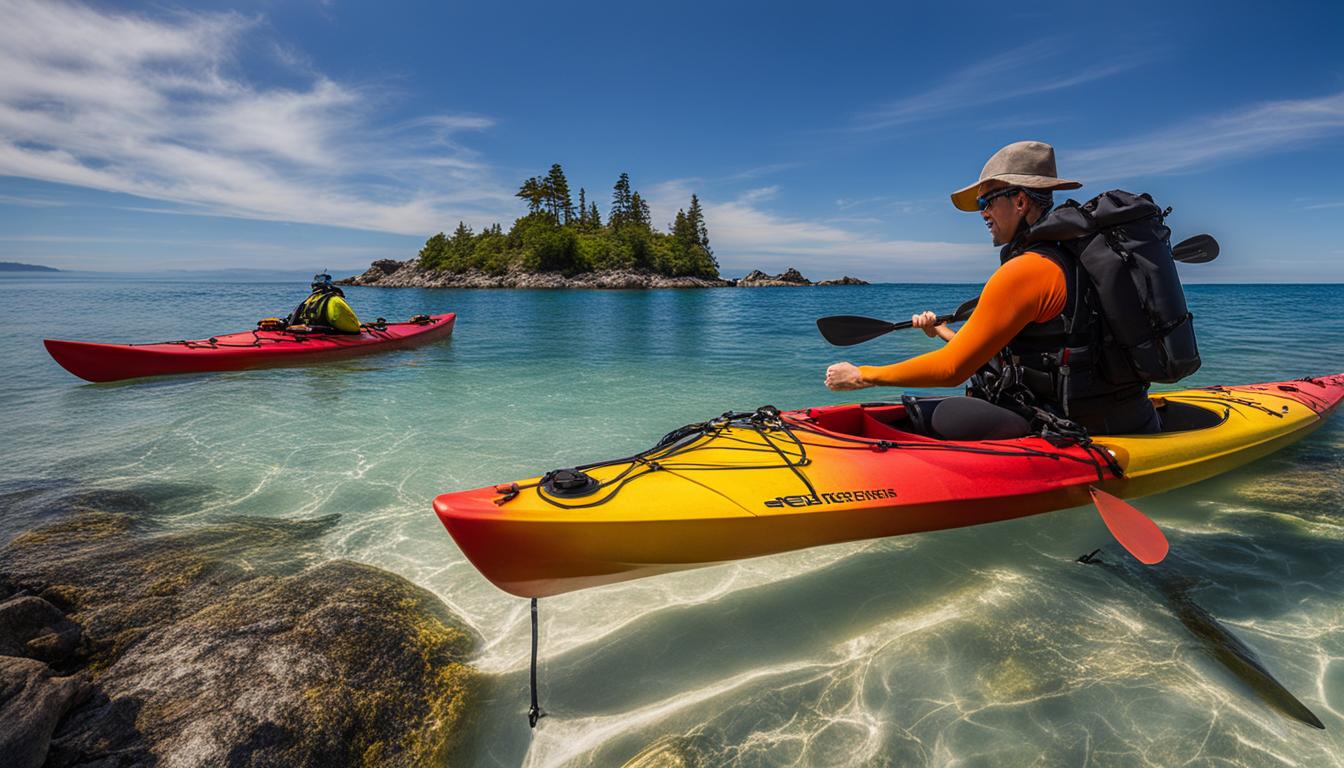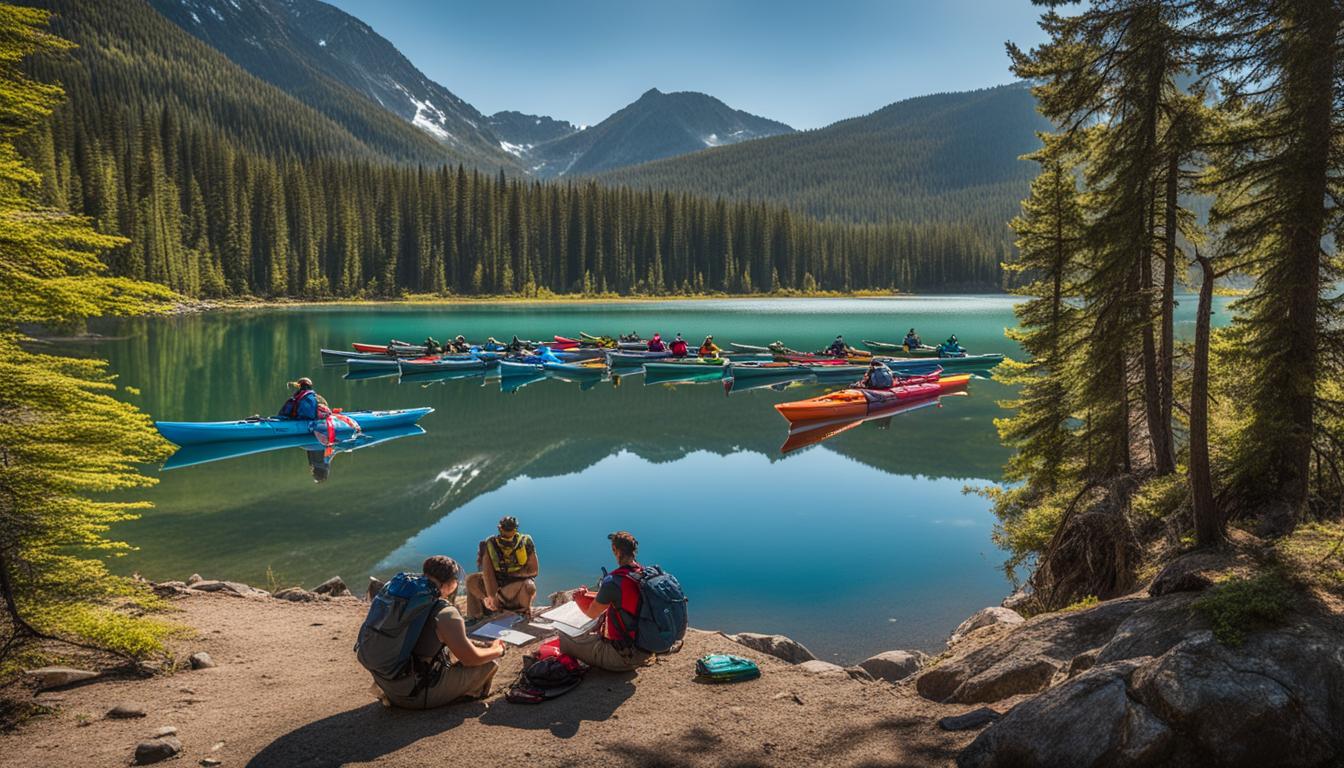When embarking on a kayak camping trip, it’s important to have the right navigational tools to ensure a safe and enjoyable journey. From GPS devices to compasses, having the proper equipment can help you master maritime navigation. Make sure to pack light and use smaller dry bags for efficient storage. Keep heavier items, such as food and water, packed near the middle of your kayak for balance. Additionally, consider investing in a deck compass for accurate and reliable navigation.
Key Takeaways:
- Having the right navigational tools is essential for a safe and enjoyable kayak camping trip.
- Pack light and use smaller dry bags for efficient storage.
- Keep heavier items packed near the middle of the kayak for balance.
- Consider investing in a deck compass for accurate and reliable navigation.
- GPS devices and compasses are useful tools for mastering maritime navigation.
Choosing the Right Kayak and Tent for Camping
When planning a kayak camping trip, one of the most important decisions you’ll need to make is choosing the right equipment. Your kayak and tent are two key pieces that can greatly impact your overall experience. Here are some tips to help you make the best choices.
Choosing the Right Kayak
Your kayak is your mode of transportation and should provide stability on the water. Look for a kayak that is designed specifically for camping trips, with features such as ample storage space and a stable hull design. Consider the length and width of the kayak, as it will affect its stability and maneuverability. Sit-on-top kayaks are popular for camping due to their easy entry and exit.
It’s also important to consider the weight capacity of the kayak to ensure it can carry you and your gear comfortably. Pay attention to the material of the kayak as well – plastic kayaks are durable and affordable, while fiberglass and carbon kayaks are lighter but more expensive.
Choosing the Right Tent
Your tent is your home away from home during your kayak camping trip, so it’s important to choose one that is lightweight, durable, and easy to pitch. Look for a tent specifically designed for backpacking or camping, as these tents are typically lighter and more compact. Consider the number of people who will be sleeping in the tent and choose a size that provides enough space for everyone and their gear.
Pay attention to the material of the tent as well – lightweight and waterproof materials are ideal for kayak camping trips. Look for tents with features such as rainflys and bathtub floors to provide protection from the elements. Finally, practice setting up your tent before your trip to ensure you are familiar with the process.
By choosing the right kayak and tent for your kayak camping trip, you can set yourself up for a comfortable and enjoyable adventure. Take the time to research and test out different options to find the equipment that best suits your needs and preferences.
Essential Accessories for Kayak Camping
When it comes to kayak camping, having the right navigational tools is crucial for a successful and safe adventure. In addition to basic tools like compasses and GPS devices, there are several accessories that can enhance your kayak camping experience and provide accurate navigation.
Electronic Navigation Aids
Electronic navigation aids, such as GPS devices, offer real-time location information and can help you navigate more efficiently. These devices are compact, lightweight, and designed specifically for outdoor activities like kayaking. With their advanced features, you can track your progress, mark waypoints, and plan your route with ease. GPS devices are an essential accessory that provides accurate and reliable navigation for kayak campers.
Kayak Route Planning Software
Another valuable accessory for kayak campers is kayak route planning software. This software allows you to map out your journey before you hit the water. You can input your starting point, destination, and points of interest along the way. The software will then generate a detailed route with important information such as distance, estimated time of arrival, and potential challenges. With kayak route planning software, you can ensure that you stay on the right track and make the most of your kayak camping trip.
| Accessories | Benefits |
|---|---|
| Electronic Navigation Aids | Provides real-time location information and accurate navigation |
| Kayak Route Planning Software | Allows you to map out your journey and stay on the right track |
“Having the right navigational tools can greatly enhance your kayak camping experience and ensure that you navigate safely and efficiently.”
By equipping yourself with essential accessories like electronic navigation aids and kayak route planning software, you can navigate the waters confidently and enjoy the beauty of nature without worrying about getting lost. These accessories provide accurate navigation, allowing you to focus on the journey and make the most of your kayak camping adventure.
Packing Tips for Kayak Camping
When it comes to kayak camping, packing efficiently is key. Not only does it ensure that you have everything you need for your trip, but it also helps maintain balance and stability in your kayak. Here are some essential packing tips for a successful kayak camping adventure.
Organize Your Gear
Before you start packing, take the time to organize your gear. Sort your items into categories, such as camping equipment, cooking utensils, personal hygiene, and clothing. This will make it easier to pack and locate items when you need them. Utilize waterproof dry bags to protect your gear from water damage and keep them organized.
- Use smaller dry bags for efficient storage and easy access to essential items.
- Pack heavier items, such as food and water, near the middle of your kayak to maintain balance.
- Place frequently used items, like sunscreen and snacks, in easily accessible compartments.
By organizing your gear and packing strategically, you can save space and make the most of your kayak’s storage capacity.
Navigating Rivers While Kayaking
Kayaking on rivers requires a different set of skills compared to open water paddling. It’s important to understand how to safely navigate rivers to avoid obstacles and strong currents. Here are some tips for navigating rivers while kayaking:
- Study the river’s flow and plan your route accordingly. Be aware of any potential hazards, such as rocks, rapids, or downed trees.
- Identify and follow the main current. Avoid eddies, which can be turbulent and difficult to paddle through.
- Use proper paddling techniques, such as edging your kayak and using sweep strokes, to maneuver around obstacles.
- Always wear a personal flotation device (PFD) and helmet for added safety.
By practicing these techniques and staying alert, you can have a safe and enjoyable experience while kayaking on rivers.
Essential Items for Safety
When embarking on a kayak camping trip, it’s crucial to pack essential items that can help you stay safe in case of emergencies. Here are some must-have items:
- A first aid kit with basic medical supplies for treating injuries.
- Repair tools, such as a multi-tool or duct tape, for fixing any equipment issues.
- Emergency signals, such as a whistle or signal mirror, for attracting attention if needed.
These items can provide you with peace of mind and ensure that you’re prepared for any unforeseen circumstances that may arise during your kayak camping trip.
By following these packing tips and staying prepared, you can embark on a kayak camping trip knowing that you have everything you need for a safe and enjoyable adventure. Remember to pack efficiently, organize your gear, and stay informed about river navigation techniques to make the most of your experience.
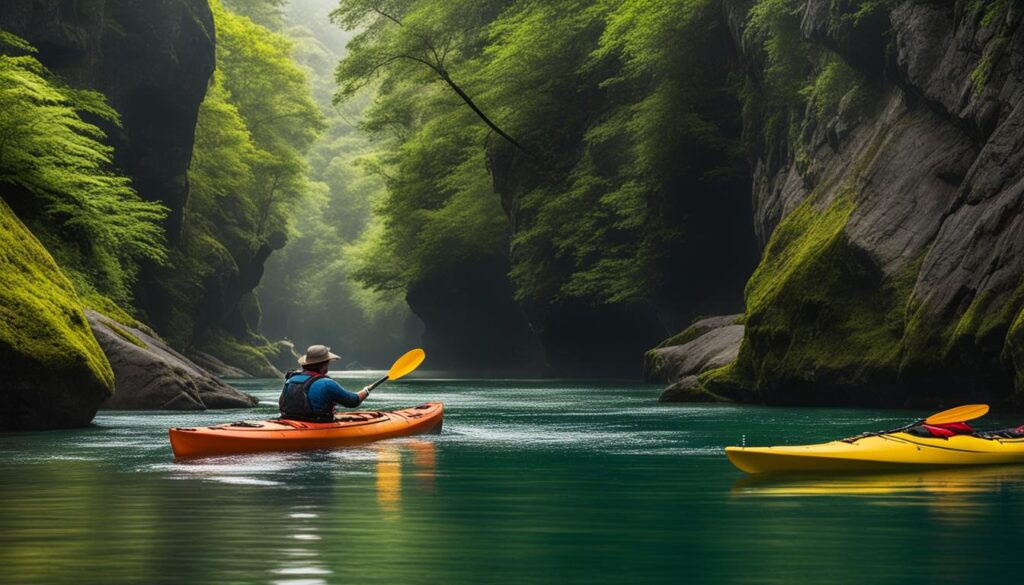
Clothing and Gear for Kayak Camping
When preparing for a kayak camping trip, it’s important to dress appropriately and have the necessary gear. Wearing the right clothing can ensure comfort and protection while out on the water. Opt for synthetic materials that dry quickly and provide insulation even when wet. Additionally, wearing a wetsuit or drysuit can help regulate body temperature in colder conditions.
Don’t forget to protect yourself from the sun’s harmful rays. Apply sunscreen with at least SPF 30 to exposed areas of your skin, and consider wearing a hat and sunglasses for added protection.
As for gear, investing in reliable navigational tools is crucial for a safe and successful kayak camping trip. GPS devices and compasses are essential for accurate navigation. GPS devices provide real-time location information, while compasses ensure you stay on the right course. Additionally, consider undergoing kayak navigation skills training to enhance your abilities on the water.
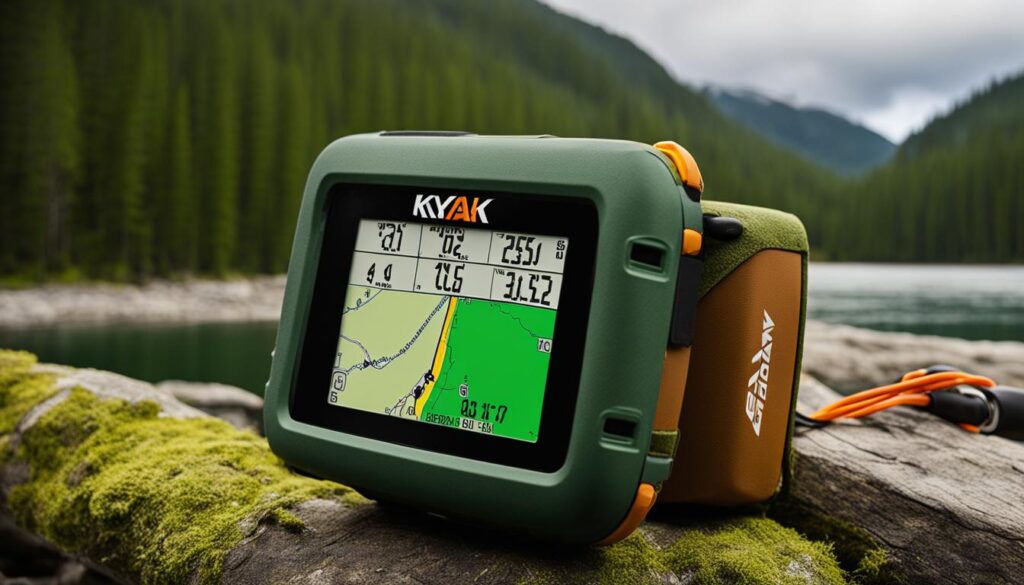
Lastly, don’t forget to bring along kayak camping topographic maps. These maps provide detailed information about the surrounding area, including waterways, landmarks, and potential camping sites. Having a good understanding of the terrain can greatly enhance your navigation skills and help you make informed decisions while on your kayak camping trip.
Conclusion
When it comes to kayak camping, having the right navigational tools is essential. Whether you prefer traditional methods like compass navigation or advanced devices like GPS, these tools can ensure a safe and enjoyable journey.
Make use of kayak trip mapping tools and kayak route planning software to enhance your navigation skills. These tools can help you chart your course and stay on track while exploring rivers and waterways.
Remember to pack light and balance your kayak for optimal performance. Dress appropriately for the water and consider investing in electronic navigation aids like chart plotters and GPS devices for accurate and reliable navigation. Additionally, kayak camping topographic maps can provide valuable information about the terrain and help you plan your journey.
Lastly, undergoing kayak navigation skills training can significantly improve your abilities on the water. These training programs will equip you with the knowledge and confidence to navigate rivers while kayaking.
FAQ
What navigational tools do I need for kayak camping?
It’s important to have GPS devices, compasses, and kayak trip mapping tools for effective navigation.
How do I choose the right kayak and tent for camping?
Look for a kayak that offers stability on the water and consider using kayak trip mapping tools and topographic maps. Choose a lightweight and easy-to-pitch tent for protection from the elements.
Are there any accessories that can enhance my kayak camping experience?
Yes, you can use kayak route planning software and electronic navigation aids, such as GPS devices, for accurate and reliable navigation.
How should I pack for a kayak camping trip?
Pack essential items, use waterproof dry bags, and maintain balance in your kayak by packing heavier items near the middle.
What clothing and gear do I need for kayak camping?
Wear synthetic clothing suitable for the water and always wear sunscreen. Consider using GPS devices, compasses, and kayak camping topographic maps for navigation. Undergo kayak navigation skills training to enhance your abilities on the water.

